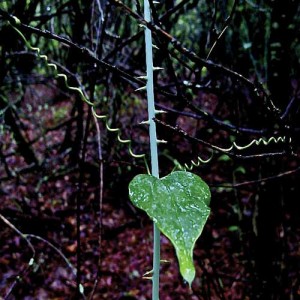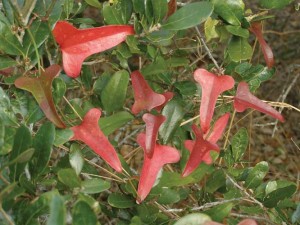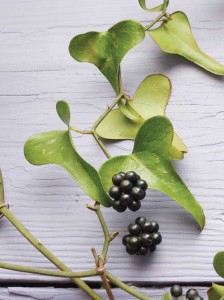Behold the catbriers
By Ken Moore
Local architect Giles Blunden has a passion for photographing mushrooms. When asked to verify the identity of his mushroom images, I refer him to recently retired botany librarian and local historian Bill Burk, who really knows his mushrooms. When Giles focuses on other plants, I’m on firmer ground. Last summer, when he asked,
“Ken, what’s this?†showing me a remarkable image among his mushrooms, I recognized a common native vine.
“Where did you find that catbrier?†I asked, and he replied, “While photographing mushrooms in the mountains near Asheville.†When accused of computer enhancement, he declared that his image was exactly what he saw. And indeed, I recollect seeing that unbelievable turquoise-blue color on stems of catbriers from time to time, even here in our local area.
From mountaintops to seacoasts, the vegetation of our state seems to be heldin place by one or more of several species of catbrier, Smilax spp. Descriptive common names include sawbrier, greenbrier and bamboo-vine.
A few weeks ago, while walking the Springer’s Point Preserve on Ocracoke Island, I encountered brilliant-red leaves on some of the catbriers there. With evergreen entangling vines above and strong tuberous root systems below, catbriers are effectively securing dunes and shorelines against wind and surf action. You may remember discovering knobby, potato-like roots washing up on seashores and sound sides. Those are remnants of the tough storage roots of catbriers.
Many folks consider catbrier a thorny pest, an impenetrable natural barbed-wire fencing. Perhaps smilax was the inspiration for barbed wire. In response to those who find it a menace, I suggest simply stepping around it, acknowledging that smilax tangles provide shelter for many wild critters. And the berries, brilliant-red on two species and dark blue-black on the others, provide nourishment for birds and other wildlife.
For us humans, tender shoots, tendrils and leaves of catbriers eaten raw are treats, according to ethnobotanist James Duke. Peterson’s Edible Wild Plants offers several recipes for tasty preparations of tender plant parts.
Some catbriers are deciduous and others are evergreen. In parts of the South, evergreen catbriers are grown for shade on arbors and used for holiday greenery, like magnolia and holly. I have a black-berried, evergreen catbrier still decorating my back entrance.
Catbriers have a rich medicinal herb heritage. Leaves and roots were used for teas and poultices and even the thorns were valued as a type of acupuncture.
I always leave some naturally occurring smilax vines to grow freely along my back deck and yard trellises. Tiny greenish-yellow, lily-like flowers invite a closer look in mid-spring. The leathery round and heart-shaped leaves are attractive as the vines reach upward and outward in all directions. Some catbriers are not thorny and are attractive in flower arrangements.
So there you have it; with thorns, or without, catbriers are vines of value and beauty to behold.



Comments are closed.